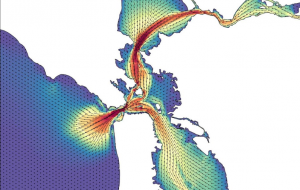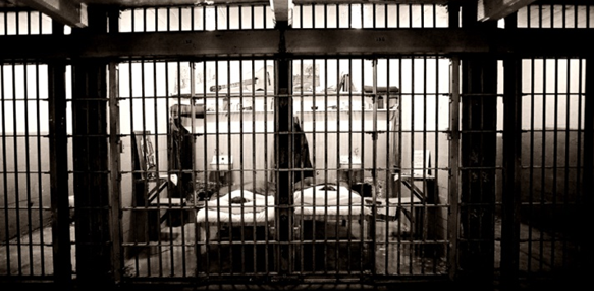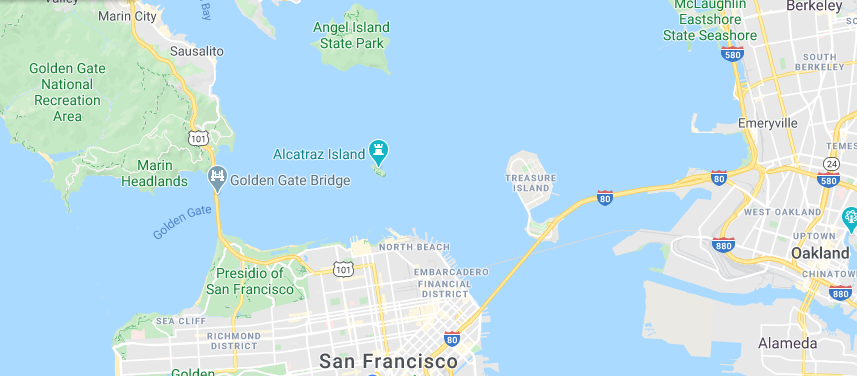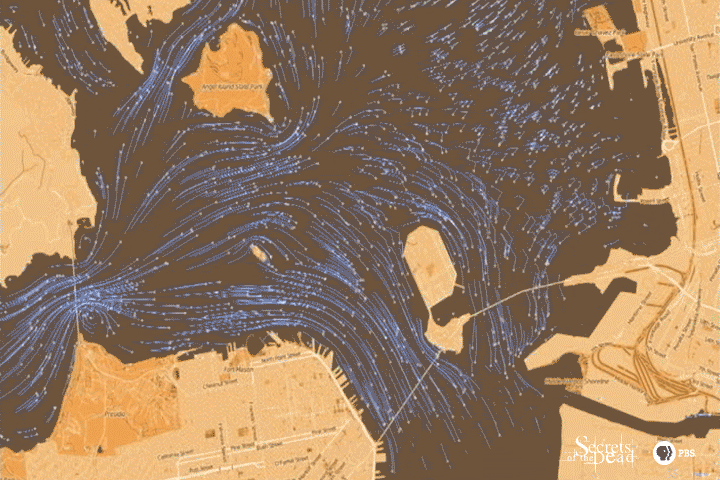 Over the night of June 11/12, 1962 three inmates broke out of the United States maximum-security penitentiary on Alcatraz Island in San Francisco Bay. They carved their way through concrete cell walls with crudely-made tools and entered a mechanical service corridor leading outside. Once over the perimeter fence, the trio fled into cold Pacific waters on a makeshift raft. The felons were never seen again. That left many to speculate whether the fugitives drowned or… if the three prisoners really survived their escape from Alcatraz.
Over the night of June 11/12, 1962 three inmates broke out of the United States maximum-security penitentiary on Alcatraz Island in San Francisco Bay. They carved their way through concrete cell walls with crudely-made tools and entered a mechanical service corridor leading outside. Once over the perimeter fence, the trio fled into cold Pacific waters on a makeshift raft. The felons were never seen again. That left many to speculate whether the fugitives drowned or… if the three prisoners really survived their escape from Alcatraz.
Alcatraz Island is a forbidding place. It’s a rugged rock just inside the entrance to San Francisco Bay near the Golden Gate Bridge. Alcatraz is highly visible from the city’s shoreline and is a well-known landmark around the world. It was once also viewed as the perfect place to build a prison.
 The lunar-like landmass covers 12 acres and hosts a hostile environment. Its tidal currents run fast and cold making Alcatraz a navigational challenge. An experienced yachts-person would think twice about trying to row around Alcatraz, especially in the dead of night. Even champion swimmers equipped with wetsuits struggle with the 1.5 mile trip to the shore.
The lunar-like landmass covers 12 acres and hosts a hostile environment. Its tidal currents run fast and cold making Alcatraz a navigational challenge. An experienced yachts-person would think twice about trying to row around Alcatraz, especially in the dead of night. Even champion swimmers equipped with wetsuits struggle with the 1.5 mile trip to the shore.
The Spanish Navy first “discovered” Alcatraz and named it La Isla de los Alcacatraces which translates to “Pelican Island” after the archaic Spanish word for the bird. There doesn’t seem to be an aboriginal name for the Island because the original settlers probably found the barren place rather worthless.
 The United States Army didn’t think that. They saw Alcatraz as the ideal spot for a military jail and developed it in the 1850s. Over time, Alcatraz Island served as a lockup and lighthouse. Common thinking held that no self-respecting prisoner would attempt something as crazy as a swimming escape from “The Rock”.
The United States Army didn’t think that. They saw Alcatraz as the ideal spot for a military jail and developed it in the 1850s. Over time, Alcatraz Island served as a lockup and lighthouse. Common thinking held that no self-respecting prisoner would attempt something as crazy as a swimming escape from “The Rock”.
The U.S. Federal Bureau of Prisons felt the same way. In 1933, the Army relinquished Alcatraz to the Justice Department who needed a secure facility to house the worst of the worst offenders. Criminals like Al Capone, Machinegun Kelly, Alvin “Creepy” Karpas, and Robert Stroud (the psychotic Birdman of Alcatraz) served sentences in the “prison system’s prison”.
Alcatraz was a state-of-the-art, super-max facility for its time. There was a one-guard-to-three-inmate ratio with each felon occupying a single cell. But, despite the precautions, it was here in 1962 that three little-known, bank-robbing hoods made their famous escape from Alcatraz.
 Frank Lee Morris (Inmate #AZ1441) was born in 1926 to a terribly dysfunctional family. He was orphaned at age 11 and was so incorrigible that foster homes refused to have him. By 13, Morris was already in jail for crimes ranging from armed robbery to narcotic trafficking. Prison authority tests placed Frank Morris in the top 2 percent of inmates when it came to intelligence with a 133 IQ. He was a leader, a conman, and a calculator. Morris arrived on Alcatraz in 1960 with a 10-year bank robbery sentence.
Frank Lee Morris (Inmate #AZ1441) was born in 1926 to a terribly dysfunctional family. He was orphaned at age 11 and was so incorrigible that foster homes refused to have him. By 13, Morris was already in jail for crimes ranging from armed robbery to narcotic trafficking. Prison authority tests placed Frank Morris in the top 2 percent of inmates when it came to intelligence with a 133 IQ. He was a leader, a conman, and a calculator. Morris arrived on Alcatraz in 1960 with a 10-year bank robbery sentence.
John William Anglin (Inmate #AZ1476) was an east-coast criminal. He was also a broken-home product in a family of 13 kids birthed by migrant farmworkers. John Algrin was 30 years old when he arrived on Alcatraz in the fall of 1960. His sentence was 15-20 years for a string of Alabama bank robberies committed with his younger brother Clarence.
 Clarence Anglin (Inmate #AZ1485) was a year behind his brother John in age. However, he was just as bad when it came to criminal behavior. Clarence Anglin’s first conviction was for breaking into a service station when he was 14 and he continued on from there. He entered Alcatraz in January 1961 with a 20-year penalty earned after 10 years of robbing everything from banks to brothels.
Clarence Anglin (Inmate #AZ1485) was a year behind his brother John in age. However, he was just as bad when it came to criminal behavior. Clarence Anglin’s first conviction was for breaking into a service station when he was 14 and he continued on from there. He entered Alcatraz in January 1961 with a 20-year penalty earned after 10 years of robbing everything from banks to brothels.
Frank Morris and the Anglin brothers didn’t meet in Alcatraz. They went back to being co-inmates in a Florida prisoner where they made repeated escape attempts. Deemed candidates for the Alcatraz treatment, the U.S. Bureau of Prisons sequentially classified them as high-risk offenders and transferred them to The Rock one-by-one. Somehow, the three were assigned to adjacent cells.
The Morris-Anglin escape plan started in December 1961. That was six months before the breakout which gave them plenty of time to think and prepare. Their plan was elaborate, and it took a tremendous amount of coordination and cooperation with the inmate population to pull off. It seems the inevitable escape was one of the worst-kept secrets inside the criminals’ culture.
The escapees used self-made tools modified from old saw blades and kitchen utensils to chip concrete around existing ventilation ducts at floor level in their cells. Their creativity extended to using a power drill made from a stolen vacuum cleaner motor which they ran during music hour in the evening. To conceal their tunneling, they fabricated fake ventilation covers painted on cardboard.
 The enlarged vent ducts gave them access to a 3-foot wide service corridor that was unpatrolled. This led to a larger area where they smuggled-in around 50 rubber raincoats donated by other inmates. The investigation later showed Morris and the Anglins built an inflatable raft and blow-up life jackets with the raincoats by vulcanizing the rubber on the facility’s steam pipes.
The enlarged vent ducts gave them access to a 3-foot wide service corridor that was unpatrolled. This led to a larger area where they smuggled-in around 50 rubber raincoats donated by other inmates. The investigation later showed Morris and the Anglins built an inflatable raft and blow-up life jackets with the raincoats by vulcanizing the rubber on the facility’s steam pipes.
To inflate the raft and personal flotation devices (PFDs), they got even more ingenious. They pilfered a musical instrument called a concertina which is an accordion-like device they converted into a bellows. The trio also sourced wood scraps and screws to build paddles.
 On the escape night, the three simulated themselves in bed by stuffing clothes and towels under the blankets to build body shapes. What really topped-off their attention to detail was fabricating human heads with paper mache that were authentically painted with flesh tones. They even attached human hair sourced from the Alcatraz barbershop.
On the escape night, the three simulated themselves in bed by stuffing clothes and towels under the blankets to build body shapes. What really topped-off their attention to detail was fabricating human heads with paper mache that were authentically painted with flesh tones. They even attached human hair sourced from the Alcatraz barbershop.
Getting out of the prison facility took some doing. The fleeing felons used a ventilation shaft from the corridor to climb to the roof and then shinnied two stories down to the ground along service lines. Then, they faced inner and outer perimeter fences topped with barbed wire before making the shore.
How they hauled the raft, paddles, and some limited personal effects through this route is not clear. It took determination and considerable physical dexterity. However, the cons did it, and it worked.
The three were discovered missing during the 7 am stand-to and head-count. This set off a massive search done by the prison officials with the help of the local police and the Coast Guard. Bit-by-bit, pieces of their escape showed up.
Alcatraz Island National Park sits to the south-west of San Francisco Bay. It’s 1 ½ miles north of downtown San Francisco, about 3 ½ miles east of the Golden Gate Bridge and Horseshoe Bay in Marin County, and just over 2 miles south of Angel Island. Alcatraz is also slightly under 3 miles west of Treasure Island.
The searchers found their evidence near Angel Island. That included a broken paddle, two deflated life vests, shreds of raincoat material, and a wallet containing contact information for the Anglin relatives. Examination of one life jacket noted deep teeth marks in the inflation piece indicating that the wearer may have been struggling against air loss.
 The main search lasted for two weeks. There were no signs of the Anglins or Morris, either alive or dead. Who aided the investigation was Allen West, an Alcatraz inmate who was part of the escape plot but couldn’t get through his enlarged ventilation duct in time to join the party.
The main search lasted for two weeks. There were no signs of the Anglins or Morris, either alive or dead. Who aided the investigation was Allen West, an Alcatraz inmate who was part of the escape plot but couldn’t get through his enlarged ventilation duct in time to join the party.
West cooperated in exchange for immunity from punishment. He revealed the planning and the escapee’s intentions. According to West, the plot was to paddle the raft west from Alcatraz and land near Horseshoe Bay near the north end of Golden Gate Bridge. Here, they intended to steal clothes, a vehicle, rob some money, and then head for the Mexican border.
The investigators took West seriously. They followed every lead linking to car thefts, clothes swiping, and hold-ups. Nothing even remotely matched a modus operandi that indicated the trio had landed anywhere in the San Francisco Bay region.
Over time, many tips came in but nothing panned out. Some information was well-intended but wrong. Others were obviously pranks and hoaxes. There was one reported sighting of a man’s body floating in the Bay area that described it as wearing denim clothes consistent with prison garb. It was never found.
 Another lead surfaced years later, and it came along with photographs. A long-time con-man claimed to have seen the Anglin brothers in Brazil and took their photos. By this time, the FBI had closed the case after writing off the escapees as having succumbed to hypothermia and drowned on the night of their mission. The U.S. Marshalls, however, took the photos seriously and sent investigators to Brazil. Nothing amounted to this but, today, there’s still speculation it might have been them.
Another lead surfaced years later, and it came along with photographs. A long-time con-man claimed to have seen the Anglin brothers in Brazil and took their photos. By this time, the FBI had closed the case after writing off the escapees as having succumbed to hypothermia and drowned on the night of their mission. The U.S. Marshalls, however, took the photos seriously and sent investigators to Brazil. Nothing amounted to this but, today, there’s still speculation it might have been them.
So, what are the chances the three prisoners really survived their escape from Alcatraz?
The answer lies in the water. The reason authorities selected Alcatraz as a maximum-security prison site was because of how nasty the water conditions surrounding the island were. The temperature, currents, and wind conditions made this spot nearly impossible to cross without the right knowledge, timing, and equipment.
San Francisco Bay is a large water body that drains about 40 percent of California. Combining its inlets and estuaries, the bay area exceeds 1,500 square miles. That water gets flushed twice a day by ebb and flow tides that have to pass through the mile-wide Golden Gate narrows. This creates tremendous current action and some of the fastest waters on the California coast.
The logical escape plan for Morris and his Anglin accomplices would be to use the tide currents to their advantage. That would have to be when the ebb or outward action was happening, and the currrent would carry them from Alcatraz to their apparent destination near Horseshoe Bay on the Marin County shore. This would move them the fastest and minimize their paddling.
If they didn’t plan their water trip with a favorable tide, the flow tide would carry them into the bay and swirl their raft like in a toilet bowl. Surely these convicts who went to an elaborate escape effort would have considered the tide timing. That’s exactly what Allen West said they did.
Historical tide records are available online at the National Oceanic and Atmospheric Administration (NOAA) website. A little Googling found the tidal information for San Francisco Bay at the Alcatraz Island area for the night of Monday, June 11 and Tuesday, June 12, 1962. Here’s what was going on:
- High tide of 5.24 feet at 7:11 pm on June 11
- Low tide of 1.47 feet at 1:39 am on June 12
- High tide of 3.69 feet at 7:27 am on June 12
To understand tide-talk, the figures 5.24 feet, 1.46 feet, and 3.69 feet refer to water levels above the mean or average low watermark. An important part of tidal water navigation is working with what’s called slack tide. This is the short period between ebb and flow when the current is neutral.
Low slack tide happened between Alcatraz Island and the Golden Gate narrows at 1:39 am on the Tuesday morning. Before that, there was a strong ebb or outflow current moving a significant water exchange between the earlier high at 5.24 feet and the low at 1.47 feet. That meant that 3.77 feet of water depth changed from a 1,500 square mile bay area and sent it whooshing beside Alcatraz and under the bridge.
 Should the escapees have missed their window of opportunity from the prison “lights-out” at 10:00 pm and the low slack time at 1:39 am, they’d have faced an incoming flow tide returning a 2.22 foot rise in water coming back into San Francisco Bay. It would’ve been a challenge to paddle a homemade raft into that force.
Should the escapees have missed their window of opportunity from the prison “lights-out” at 10:00 pm and the low slack time at 1:39 am, they’d have faced an incoming flow tide returning a 2.22 foot rise in water coming back into San Francisco Bay. It would’ve been a challenge to paddle a homemade raft into that force.
So, it looks like the escapees had about 3 ½ hours to crawl out of their cells, haul their gear over the fence, and catch a favorable tide to make it 3 ½ miles to freedom at Horseshoe Bay. That seems do-able… except for the wild card.
Every trained mariner respects the wind. Air movement can be good or bad depending on your vessel type and travel direction. More Google exploration found the San Francisco weather records for June 11/12, 1962. It was a cool and cloudy night with a west to southwest wind coming in off the open Pacific at a steady 10-13 mile-per-hour blow with gusts up to 21 miles-per-hour.
 The escapees and their blow-up raft would have paddled into an oncoming wind which certainly would have worked against the tide power. In fact, this combination of an inflow wind hitting an outflow tide makes for choppy surface conditions, especially in shallow water. The wind and tide action also create whirlpools which seriously suck to paddle through.
The escapees and their blow-up raft would have paddled into an oncoming wind which certainly would have worked against the tide power. In fact, this combination of an inflow wind hitting an outflow tide makes for choppy surface conditions, especially in shallow water. The wind and tide action also create whirlpools which seriously suck to paddle through.
San Francisco Bay is notoriously shallow as large inlets go. That’s a major reason why the U.S. Navy chose San Diego as a main port over more centrally-located San Francisco. The average depth of San Francisco Bay is 20 feet which is less than the draft on most freighter ships. The deepest part of the bay is a 300-foot underwater canyon on the north side of the Golden Gate narrows that creates significant turbulence during tide changes.
It’s an understatement to say the water surface conditions were challenging for the escapees. It seems obvious they intentionally chose that period to run as it gave them the best odds of making it. They had favorable moonlight conditions with a ¾ waxing image being blocked by high cloud. According to weather records, nautical twilight occurred at 9:42 pm on June 11 and nautical sunrise occurred at 4:37 am. Therefore, they certainly had the cover of darkness.
 Weather records indicate there was no rain, there was a high barometric pressure of 102.1, and a relatively cool nighttime air temperature of 48-50 degrees Fahrenheit. With the windchill, it would feel more like the mid-40s. The water temperature was a different story. NOAA recorded the waters surrounding Alcatraz to be 47 degrees Fahrenheit on the outflow and 50 degrees Fahrenheit on the inflow. That’s due to the colder freshwater coming into San Francisco from the Sacramento River’s spring melt and the warmer Pacific saltwater returning.
Weather records indicate there was no rain, there was a high barometric pressure of 102.1, and a relatively cool nighttime air temperature of 48-50 degrees Fahrenheit. With the windchill, it would feel more like the mid-40s. The water temperature was a different story. NOAA recorded the waters surrounding Alcatraz to be 47 degrees Fahrenheit on the outflow and 50 degrees Fahrenheit on the inflow. That’s due to the colder freshwater coming into San Francisco from the Sacramento River’s spring melt and the warmer Pacific saltwater returning.
There’s a picture emerging of three desperate men with little tidal water experience making an untested run for freedom using their human technology against nature’s elements. The escapees calculated their timing to use darkness and an ebb tide to carry them along, so they took their chances. What they may have failed to consider is the subterranean characteristics of the bay and air power.
Their raft was also untested. Same with their life jackets. It’s hard to say what happened once the men’s weight put pressure on the inflated raft and jacket seams. Leaks likely started early in their journey, and this would have made paddling hard. Probably, the harder they struggled, the more force they exerted on their raft and buoyancy devices which possibly failed.
 If Frank Morris, John Anglin, and Clarence Anglin ended up in the water, their life-expectancy would be limited. An average man, with a thin build like these escapes had, would go numb within a few minutes. According to charts by the U. S. Coast Guard , in water temperature between 41 and 50 degrees Fahrenheit, this scenario would happen:
If Frank Morris, John Anglin, and Clarence Anglin ended up in the water, their life-expectancy would be limited. An average man, with a thin build like these escapes had, would go numb within a few minutes. According to charts by the U. S. Coast Guard , in water temperature between 41 and 50 degrees Fahrenheit, this scenario would happen:
- Shock Setting — 1 to 3 minutes
- Exhaustion Onset — 30 to 60 minutes
- Certain Death — 1 to 3 hours
Did the escapees survive? We’ll likely never know for sure. There is no conclusive proof one way or the other. There are urban legends and family suggestions that at least the Anglin brothers made it to safety, but you have to question the source. It’s theoretically possible for three men in a rubber boat to go from their cells to shore in a 3 ½ hour period, but they’d need a dose of luck from the escape gods.
 However, their bodies have never been found. Some historical unidentified remains were recently examined through DNA testing which eliminated the Anglins from being a recovered John Doe. So far, forensic investigators haven’t been able to rule out Frank Morris, as he has no known living relatives to get a DNA comparison standard from.
However, their bodies have never been found. Some historical unidentified remains were recently examined through DNA testing which eliminated the Anglins from being a recovered John Doe. So far, forensic investigators haven’t been able to rule out Frank Morris, as he has no known living relatives to get a DNA comparison standard from.
If the Anglins and Morris did perish in San Francisco Bay, it’s not surprising their bodies didn’t surface – especially if their life vests failed. Typically, human bodies initially sink when immersed in water. Bodies then respond to environmental conditions like temperature and salinity.
San Francisco Bay was cold in June of 1962. It also had high freshwater content due to the late-spring runoff. Bodies tend to float better in saltwater than freshwater, but they need a reasonable amount of gas to do so. With the ambient temperature being so low, it’s unlikely there’d be sufficient postmortem gas generated to cause buoyancy. If the men sank, the tidal action would have pushed them around for a while and then dropped them off in the deepness of the sea where they’d permanently decompose.
On the balance of probabilities, it’s unlikely the three prisoners really survived their escape from Alcatraz. However, there’s always a chance given the time frame they had. If they did and were still alive, they’d be old men by now. The FBI gave up the chase a long time ago, but the U. S. Marshalls still have an open file. They have a reward for you… if you can find them.





